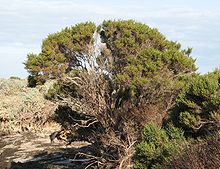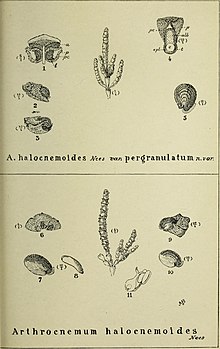Tecticornia
| Tecticornia | ||||||||||||
|---|---|---|---|---|---|---|---|---|---|---|---|---|

|
||||||||||||
| Systematics | ||||||||||||
|
||||||||||||
| Scientific name | ||||||||||||
| Tecticornia | ||||||||||||
| Joseph Dalton Hooker |
Tecticornia is a genus of plants in the foxtail family (Amaranthaceae). The numerous types are mainly found in Australia, one type ( Tecticornia indica ) also occurs on the tropical coasts of Asia and Africa.
description


Vegetative characteristics
The Tecticornia styles are annual or perennial herbaceous plants , semi-shrubs or small shrubs . The branched stems are bare and appear articulated. The leaves are opposite, they are fleshy, glabrous, overgrown below and surrounding the stem in a cup or collar shape, with a missing or one to three millimeter long, bilobed to triangular free leaf blade.
Inflorescences and flowers
The spike-like inflorescences consist of opposing, mostly overgrown bracts surrounding the stem or, in some species, free bracts , the leaf blades of which are cup-shaped to collar-shaped or triangular to rounded scaly. In each armpit there are (rarely one) usually three to five (rarely up to seven) flowers, which can be grown freely or with one another, with the bract and the inflorescence axis. The hermaphroditic or, more rarely, unisexual flowers have a two- to three-lobed flower cover made of fused tepals , a stamen , and an ovary with two stigmas .
Fruits and seeds
At the time of fruiting, the perianth remains membranous or becomes crusty, spongy or horny. The pericarp can be membranous, fleshy, crusty or woody. The disc-shaped or wedge-shaped seed has a smooth or network-like, humped or longitudinally ribbed surface. The embryo is curvy. The seed contains abundant nutrient tissue.
distribution
The types of Tecticornia are all common in Australia . The only exception is Tecticornia indica ( Syn. Halosarcia indica , Arthrocnenum indicum ) also outside the continent on the tropical coasts of the Indian Ocean to eastern and western tropical Africa .
Systematics
The genus Tecticornia was established by Joseph Dalton Hooker in 1880 . The type species is Tecticornia cinerea (F. Muell.) Baill , which is a synonym of Tecticornia australasica (Moq.) Paul G. Wilson . In phylogenetic studies of salicornioideae the lineage with proved Tecticornia / Halosarcia as the sister group of Sarcocornia / Salicornia - clade . Tecticornia was a small genus with only three species until 2007 , since then the genera Halosarcia , Pachycornia , Sclerostegia and Tegicornia have also been included here.
The genus currently (2016) comprises about 44 species, 11 of which have only recently been described. Unless otherwise stated, the distribution information comes from the Australian Plant Census (2008).
- Tecticornia annelida K.A. Sheph . & M. Lyons , in Western Australia .
- Tecticornia arborea Paul G.Wilson , in Western Australia.
- Tecticornia arbuscula (R.Br.) KASheph. & Paul G.Wilson , widely used in Australia (Western Australia, South Australia , New South Wales , Victoria , Tasmania ).
- Tecticornia auriculata (Paul G.Wilson) KASheph. & Paul G. Wilson , in Western Australia.
- Tecticornia australasica (Moq.) Paul G.Wilson , in Australia ( Northern Territory , Queensland )
- Tecticornia bibenda K.A. Sheph . & SJvan Leeuwen , in Western Australia.
- Tecticornia bulbosa (Paul G.Wilson) KASheph. & Paul G. Wilson , in Western Australia.
- Tecticornia calyptrata (Paul G.Wilson) KASheph. & Paul G.Wilson , in Australia (Western Australia, Northern Territory).
- Tecticornia chartacea (Paul G.Wilson) KASheph. & Paul G. Wilson , in Western Australia.
- Tecticornia cupuliformis (Paul G.Wilson) KASheph. & Paul G.Wilson , in Australia (South Australia, Queensland).
- Tecticornia cymbiformis K.A. Sheph. & Paul G. Wilson , in Western Australia.
- Tecticornia disarticulata (Paul G.Wilson) KASheph. & Paul G.Wilson , in Australia (Western Australia, Northern Territory, New South Wales, Tasmania).
- Tecticornia doleiformis (Paul G.Wilson) KASheph. & Paul G. Wilson , in Western Australia.
- Tecticornia entrichoma (Paul G.Wilson) KASheph. & Paul G. Wilson , in Western Australia.
- Tecticornia fimbriata (Paul G.Wilson) KASheph. & Paul G. Wilson , in Western Australia.
- Tecticornia flabelliformis (Paul G.Wilson) KASheph. & Paul G.Wilson , in Australia (Western Australia, South Australia, Victoria).
- Tecticornia fontinalis (Paul G.Wilson) KASheph. & Paul G.Wilson , in South Australia.
- Tecticornia globulifera K.A. Sheph. in Western Australia.
- Tecticornia halocnemoides (Nees) KASheph. & Paul G.Wilson , widespread in Australia (Western Australia, Northern Territory, South Australia, Queensland, New South Wales, Victoria).
- Tecticornia indefessa K.A. Sheph . , in Western Australia.
- Tecticornia indica (Willd.) KASheph. & Paul G.Wilson , widespread in Australia (WA, NT, SA, Qld, NSW, Vic) and on the tropical coasts of the Indian Ocean from Southeast Asia to South Asia , East Africa , Madagascar and Southeast Africa, as well as on the Atlantic coast of Senegal .
- Tecticornia laevigata K.A. Sheph. , in Western Australia.
- Tecticornia lepidosperma (Paul G.Wilson) KASheph. & Paul G.Wilson , in Australia (Western Australia, South Australia).
- Tecticornia leptoclada (Paul G.Wilson) KASheph. & Paul G. Wilson , in Western Australia.
- Tecticornia loriae K.A. Sheph. & M. Lyons , in Western Australia.
- Tecticornia lylei (Ewart & Jean White) KASheph. & Paul G.Wilson , in Australia (Western Australia, South Australia, New South Wales ?, Victoria).
- Tecticornia medullosa (Paul G.Wilson) KASheph. & Paul G.Wilson , in Australia (South Australia, Queensland, New South Wales).
- Tecticornia medusa K.A. Sheph. , in Western Australia.
- Tecticornia mellaria K.A. Sheph . , in Western Australia.
- Tecticornia moniliformis (Paul G.Wilson) KASheph. & Paul G.Wilson , in Australia (Western Australia, Victoria).
- Tecticornia nitida (Paul G.Wilson) KASheph. & Paul G.Wilson , in Australia (South Australia, Victoria).
- Tecticornia papillata K.A. Sheph. , in Western Australia.
- Tecticornia peltata (Paul G.Wilson) KASheph. & Paul G. Wilson , in Western Australia.
- Tecticornia pergranulata (JMBlack) KASheph. & Paul G.Wilson , widespread in Australia (Western Australia, Northern Territory, South Australia, Queensland, New South Wales, Victoria).
- Tecticornia pluriflora (Paul G.Wilson) KASheph. & Paul G.Wilson , in Australia (South Australia, New South Wales).
- Tecticornia pruinosa (Paulsen) KASheph. & Paul G.Wilson , in Australia (Western Australia, Northern Territory, South Australia, New South Wales, Victoria).
- Tecticornia pterygosperma (JMBlack) KASheph. & Paul G.Wilson , in Australia (Western Australia, South Australia, New South Wales, Victoria).
- Tecticornia sparagosa K.A. Sheph . & M. Lyons , in Western Australia.
- Tecticornia syncarpa (Paul G.Wilson) KASheph. & Paul G.Wilson , in Australia (Western Australia, South Australia, Victoria).
- Tecticornia tenuis (Benth.) KASheph. & Paul G.Wilson , widespread in Australia (Western Australia, Northern Territory, South Australia, Queensland, New South Wales, Victoria).
- Tecticornia triandra (F.Muell.) KASheph. & Paul G.Wilson , widespread in Australia (Western Australia, Northern Territory, South Australia, Queensland, New South Wales, Victoria).
- Tecticornia undulata (Paul G.Wilson) KASheph. & Paul G.Wilson , in Australia (Western Australia, Northern Territory, South Australia).
- Tecticornia uniflora (Paul G.Wilson) KASheph. & Paul G.Wilson , diocese with only one flower per bract, in Western Australia.
- Tecticornia verrucosa Paul G.Wilson , in Australia (Western Australia, Northern Territory, South Australia).
use
The young twigs of Tecticornia indica can be eaten cooked as a vegetable. In Madagascar they are pickled in vinegar and used as a spice.
Individual evidence
- ↑ a b c d e f g Gudrun Kadereit, Ladislav Mucina & Helmut Freitag: Phylogeny of Salicornioideae (Chenopodiaceae): diversification, biogeography, and evolutionary trends in leaf and flower morphology , In: Taxon , Volume 55 (3), 2006, pages 623-624, 632-633.
- ↑ Joseph Dalton Hooker: Genera Plantarum ad exemplaria imprimis in herbariis Kewensibus , 3 (1), 1880, p. 65. First description scanned at BHL
- ^ Tecticornia at Tropicos.org. Missouri Botanical Garden, St. Louis, accessed August 1, 2016.
- ↑ Kelly Anne Shepherd, Paul Graham Wilson: Incorporation of the Australian genera Halosarcia, Pachycornia, Sclerostegia and Tegicornia into Tecticornia (Salicornioideae, Chenopodiaceae). , In: Australian Systematic Botany , Volume 20, 2007, pp. 319-331.
- ↑ a b Kelly Anne Shepherd, van Leeuwen, SJ: Tecticornia bibenda (Chenopodiaceae: Salicornioideae), a new C4 samphire from the Little Sandy Desert, Western Australia . In: Nuytsia 16 (2), 2007, pp. 388-390.
- ↑ a b c d Kelly Anne Shepherd: Three new species of Tecticornia (formerly Halosarcia) (Chenopodiaceae: Salicornioideae) from the Eremaean Botanical Province, Western Australia . In: Nuytsia 17 (1), 2007, 353-366.
- ↑ a b Kelly Anne Shepherd: Tecticornia indefessa (Chenopodiaceae: Salicornioideae), a new mat samphire (formerly Tegicornia) from north of Esperance, Western Australia . In: Nuytsia 17, 2007, 367-374.
- ↑ a b Kelly Anne Shepherd: Tecticornia papillata (Chenopodiaceae: Salicornioideae), a new andromonoecious samphire from near the Carnarvon Range, Western Australia . In: Nuytsia 18, 2008, pp. 261-264.
- ↑ a b c d Kelly Anne Shepherd, Michael N. Lyons: Three new species of Tecticornia (Chenopodiaceae, subfamily Salicornioideae) identified through Salinity Action Plan surveys of the central wheatbelt region, Western Australia . In: Nuytsia 19, 2009, pages 167-180.
- ↑ a b c Kelly Anne Shepherd: Tecticornia globulifera and T. medusa (subfamily Salicornioideae: Chenopodiaceae), two new priority samphires from the Fortescue Marsh in the Pilbara region of Western Australia. In: Telopea 13 (1-2), 2011, pp. 351-355.
- ^ APC - Australian Plant Census: Tecticornia , CHAH, 2008.
- ↑ Halosarcia indica at PROTA4U ( Memento of the original from August 1, 2016 in the Internet Archive ) Info: The archive link was inserted automatically and has not yet been checked. Please check the original and archive link according to the instructions and then remove this notice.


